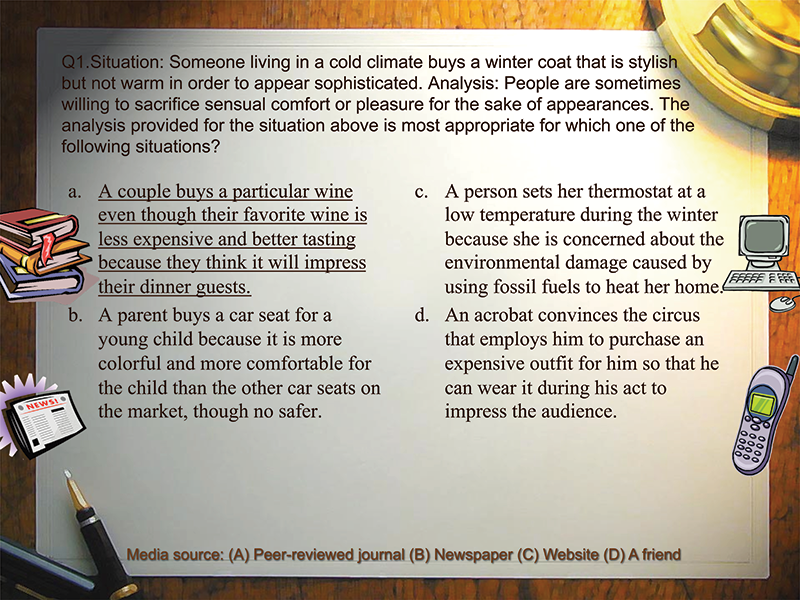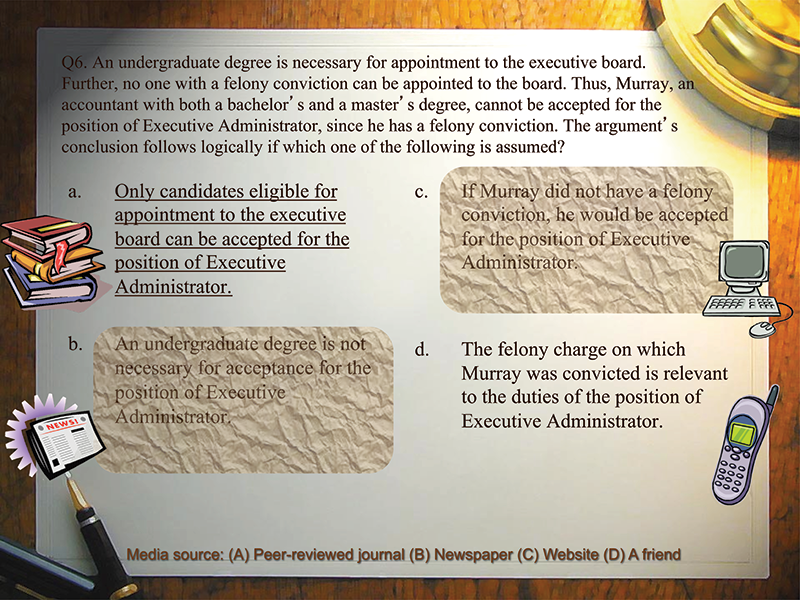Logical Reasoning
STUDENT DESIGNERS: Rasha Alsaidi, Dipali Arshad, & Janina Medina
PURPOSE: Fluency describes how easily information is processed. Fluent information is automatically processed, and disfluent information requires deliberation. Processing fluency was manipulated to determine why undergraduate students, who have been informed of the value of peer-reviewed sources, gravitate toward less reliable Internet-based sources.
METHODS: Subjects (N=864) from an undergraduate research pool were presented with a critical thinking assessment in a four-alternative forced-choice paradigm. Response choices were accompanied by icons that represented four different sources of information. In the fluent-source condition, an icon representing peer-reviewed sources was reliably paired with the correct answer 50% of the time. In the disfluent-source condition, icons were randomly paired with answers. In Experiment 2, additional assessments of confidence were obtained using a ten-item questionnaire. In Experiment 3, the fluency of the content was manipulated. Subjects in the fluent-content condition were presented with high contrast text, and subjects in the disfluent-content condition were presented with low contrast text.
RESULTS AND DISCUSSION: Subjects in the disfluent-source condition performed better than the fluent-source condition despite hints provided by the iconography. Subjects did not use the source of the information to guide decisions. Similarly, performance for the disfluent-content condition was better than for the fluent-content condition. Disfluent content conditions may have prompted closer inspection of the content, resulting in improved performance. A double dissociation between confidence and performance provided evidence for two cognitive systems, a faster intuitive system and a slower deliberative system. Collectively, these results indicate that processing fluency should be considered when designing course curricula.

FIGURE 1: Participants were presented with four possible solutions to a question. Icons accompanied each possible answer (book, newspaper, computer, and phone). Subjects were told the book icon represented a peer-reviewed source that was "highly reliable." All other icons represented sources that were "less reliable" and not peer-reviewed. In the fluent-source condition, the book, newspaper, computer, and phone icons were reliably paired with the correct answer 50%, 25%, 12.5% and 12.5%, respectively. In the disfluent-source condition, icons were randomly paired with the correct answer. After subjects indicated their preference, the correct answer was underlined on the screen.
 FIGURE 2: In addition to manipulating the source fluency during the critical thinking assessment, the perceptual fluency of the content was manipulated by altering the contrast of the font. All stimuli and procedures for the critical thinking assessment were the same as Experiment 1 and 2. For disfluent-content conditions, two answers were presented at random on a low-contrast background field. The background field was also altered to look like crumpled paper, which acted as a high-frequency mask.
FIGURE 2: In addition to manipulating the source fluency during the critical thinking assessment, the perceptual fluency of the content was manipulated by altering the contrast of the font. All stimuli and procedures for the critical thinking assessment were the same as Experiment 1 and 2. For disfluent-content conditions, two answers were presented at random on a low-contrast background field. The background field was also altered to look like crumpled paper, which acted as a high-frequency mask.
STUDENT DESIGNERS: Rasha Alsaidi, Dipali Arshad, & Janina Medina
PURPOSE: Fluency describes how easily information is processed. Fluent information is automatically processed, and disfluent information requires deliberation. Processing fluency was manipulated to determine why undergraduate students, who have been informed of the value of peer-reviewed sources, gravitate toward less reliable Internet-based sources.
METHODS: Subjects (N=864) from an undergraduate research pool were presented with a critical thinking assessment in a four-alternative forced-choice paradigm. Response choices were accompanied by icons that represented four different sources of information. In the fluent-source condition, an icon representing peer-reviewed sources was reliably paired with the correct answer 50% of the time. In the disfluent-source condition, icons were randomly paired with answers. In Experiment 2, additional assessments of confidence were obtained using a ten-item questionnaire. In Experiment 3, the fluency of the content was manipulated. Subjects in the fluent-content condition were presented with high contrast text, and subjects in the disfluent-content condition were presented with low contrast text.
RESULTS AND DISCUSSION: Subjects in the disfluent-source condition performed better than the fluent-source condition despite hints provided by the iconography. Subjects did not use the source of the information to guide decisions. Similarly, performance for the disfluent-content condition was better than for the fluent-content condition. Disfluent content conditions may have prompted closer inspection of the content, resulting in improved performance. A double dissociation between confidence and performance provided evidence for two cognitive systems, a faster intuitive system and a slower deliberative system. Collectively, these results indicate that processing fluency should be considered when designing course curricula.

FIGURE 1: Participants were presented with four possible solutions to a question. Icons accompanied each possible answer (book, newspaper, computer, and phone). Subjects were told the book icon represented a peer-reviewed source that was "highly reliable." All other icons represented sources that were "less reliable" and not peer-reviewed. In the fluent-source condition, the book, newspaper, computer, and phone icons were reliably paired with the correct answer 50%, 25%, 12.5% and 12.5%, respectively. In the disfluent-source condition, icons were randomly paired with the correct answer. After subjects indicated their preference, the correct answer was underlined on the screen.

